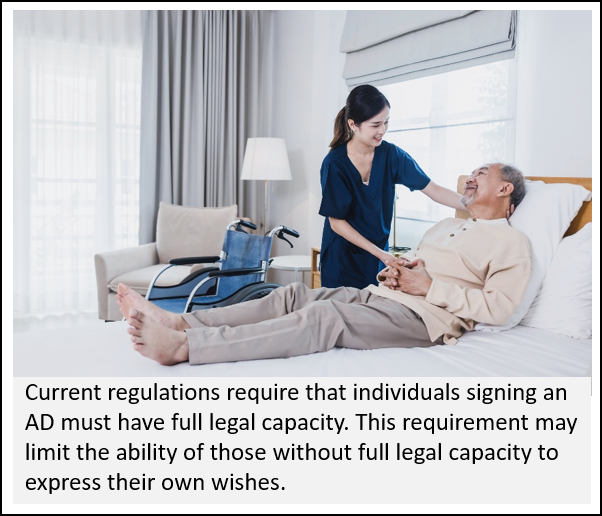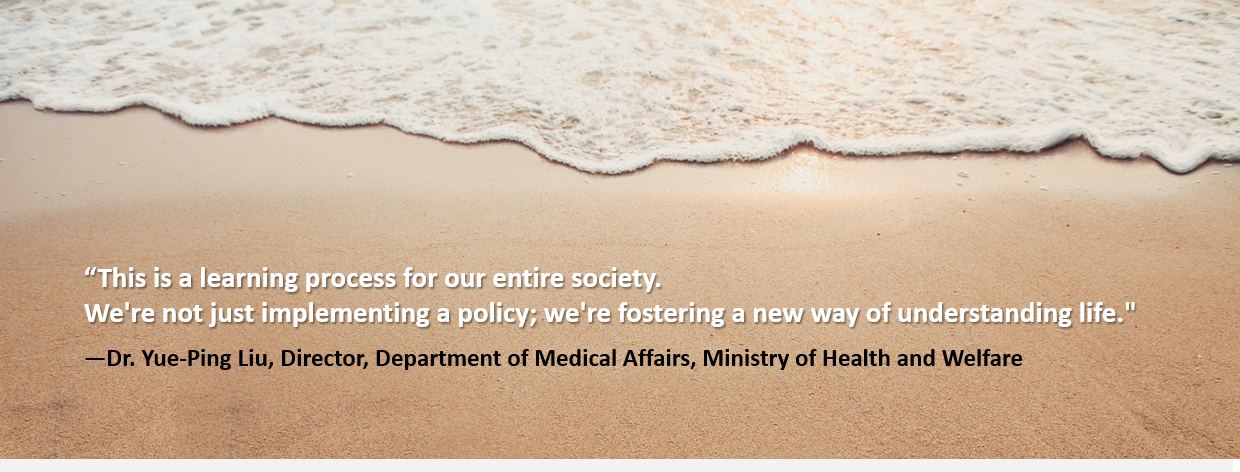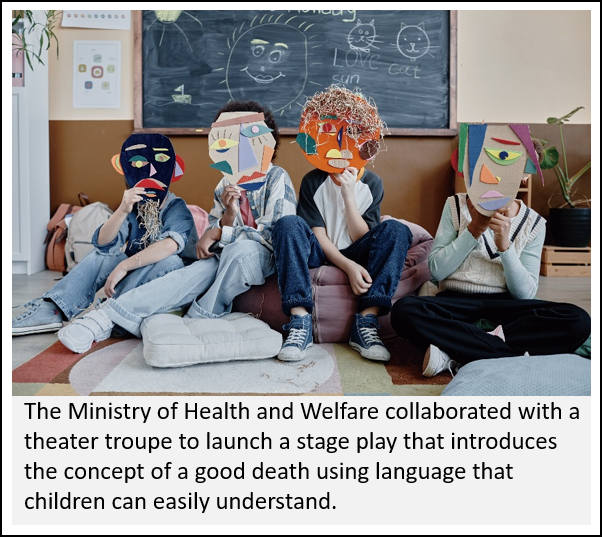In 2019, the Patient Right to Autonomy Act came into effect, making Taiwan the first country in Asia to pass a dedicated law protecting patients’ rights to make their own medical decisions. The policy enables people, while still of sound mind, to decide in advance what kinds of medical treatment they would want if they were to lose consciousness with no chance of recovery or face end-of-life decisions. It reflects the principle of personal autonomy in choosing “the kind of medical care I wish to receive.” However, as ideals meet reality, gaps in the system and obstacles to implementation have gradually surfaced.
At the age of 73, Mrs. Lin did something that deeply impressed her daughter: she arranged for an Advance Care Planning (ACP) consultation. After two in-depth sessions, she signed an Advance Directive (AD), stating that if she were to fall into an irreversible coma or a permanent vegetative state, she would decline intubation, resuscitation, and artificial nutrition. She even wrote by hand: "Please let me go peacefully."
This personal choice was made possible by Taiwan's Patient Right to Autonomy Act, which came into effect in 2019. As Asia's first dedicated law explicitly protecting a patient's right to decide one's own medical treatments, it allows individuals--while still mentally competent--to make decisions about medical care under five specific clinical situations: terminal illness, irreversible coma, permanent vegetative state, severe dementia, and other unbearable and untreatable conditions formally declared by authorities. These conditions are defined in the law and require a formal consultation process involving a team of healthcare professionals, including doctors, nurses, and social workers, before the directive can be acted upon.
What sets this law apart is that it does not require a prior diagnosis, nor does it depend on family decisions. Instead, it establishes a professional process through which individuals make their own choices, clearly stating, "When the time comes, these are the medical treatments I wish to receive, and these are the ones I refuse."
Starting from Ethics
An Institutional Experiment
"The Patient Right to Autonomy Act isn't about giving up—it's about making a choice," says Dr. Daniel Fu-Chang Tsai, Director of the Center for Biomedical Ethics at National Taiwan University Hospital. As one of the law's key advocates, Dr. Tsai has spent years focusing on medical ethics and quality end-of-life care, taking part in numerous public briefings and playing a role in shaping the system's framework. In his view, the law's essence isn't "how to end life," but rather "how to live with dignity and leave this world with autonomy." Some people wish to exhaust every possible medical option to extend life, while others prefer to let nature take its course. This legislation exists to safeguard both choices equally.
In many countries, Advance Care Planning (ACP) and Advance Directives (AD) are introduced gradually through administrative guidelines or clinical practice, building consensus over time. Taiwan, however, took the legislative-first route. While this gave the policy stronger visibility and legal weight, it also meant the public and the healthcare system had to catch up simultaneously—effectively turning it into a real-time institutional experiment with few precedents to follow.
As of early 2025, more than 93,000 people have signed an Advance Directive, representing less than 1% of Taiwan's adult population. Despite having a well-defined legal framework and a careful procedural design, the number of people who actually complete the process remains limited.
Another major hurdle is accessibility. To sign an AD, a person must be at least 18 years old, possess full legal capacity, and go through the full ACP consultation process. While these requirements are intended to protect the integrity of personal choice, they can become roadblocks in practice. Elderly individuals with mobility issues, residents in remote regions with poor transportation, or people with limited access to accurate information often find themselves unable to even begin—a situation that leaves a well-meaning system stalled at the first step.
Ideal vs. Reality
Gaps in the System Emerging
"The Patient Right to Autonomy Act emphasizes information, understanding, voluntariness, and choice," says Dr. Daniel Fu-Chang Tsai. "But in practice, it often becomes reduced to just explanation and consent." While the procedures may be followed correctly, he warns, the deeper ethical reflection and meaningful family conversations envisioned by the law can be lost when the process becomes merely a checklist of options.

There are also legal limitations in the current system. Sam-Rong Hwang, Senior Partner at Formosa Transnational Attorneys at Law, notes that the law does not adequately address the needs of individuals with conditions such as dementia or those lacking full legal capacity. Under current regulations, only adults with full legal competence may sign an Advance Directive. This excludes many people who may be mentally clear, but because they are under guardianship, cannot participate in the process even if they can still express their preferences clearly.
For example, a man in his seventies diagnosed with mild dementia may be fully capable of stating that he does not want invasive treatment and wishes to pass away naturally. However, because he has been placed under guardianship, he is legally deemed to lack full capacity and is excluded from signing an Advance Directive.
"He can still express himself clearly, but because of a diagnosis and a legal ruling, the system no longer listens," says Hwang. This design flaw, he argues, limits the very people the law was intended to protect. When legal thresholds are set too high, they risk contradicting the core principle of patient autonomy.
"This is a learning process for our entire society," says Dr. Yue-Ping Liu, Director of the Department of Medical Affairs at the Ministry of Health and Welfare. "We are not just implementing a policy; we are fostering a new way of understanding life." From her perspective, the challenges encountered along the way are part of the system's gradual process of taking root in society.
Beyond the Medical Sphere
Bringing the Policy into Everyday Life
"If we rely solely on the medical system, we can't reach a truly diverse range of communities," says Dr. Yue-Ping Liu. At the heart of the Patient Right to Autonomy Act is the idea of advance conversations, but if those conversations remain confined to hospitals, their reach is quickly limited. That's why the Ministry began expanding outreach into long-term care centers, community health clinics, libraries, and community colleges—connecting the policy to daily life and local culture.
One example is the podcast series Encounter and Foresee, which invites doctors and families to share personal experiences. The Ministry has also published a set of illustrated children's books—The Little Red Robot, Second-Oldest Brother Pig's Happiness Party, and Grandpa Sloth's Wish—which tour libraries and schools. It has even partnered with a theater troupe to stage plays explaining the concept of a good death in language children can understand.
In addition, the Ministry has integrated the three major end-of-life laws—the Human Organ Transplant Act, the Hospice and Palliative Care Act, and the Patient Right to Autonomy Act—under the Taiwan Organ Sharing Registry and Patient Autonomy Promotion Center. While each law has its own scope, they share a common principle: "When facing death, we all have the right to choose how we leave, and how we remain."

These efforts may appear small on their own, but together they create a path for the Patient Right to Autonomy Act to be seen and understood in everyday life. The aim is not simply to persuade people to sign an Advance Directive, but to plant a broader idea: that choices about life and death can—and should—be considered well in advance.
"Patient autonomy doesn't begin at the moment of signing a document; it begins the moment someone realizes they have the right to choose," says Dr. Daniel Tsai. He notes that the medical field has long avoided conversations about death, but through this policy’s outreach, such discussions between professionals, patients, and families are becoming less difficult. And this kind of education, he emphasizes, must be carried out by society as a whole.
Patching the Gaps Without Amending the Law
Rethinking Systems and Roles
Although the framework of the Patient Right to Autonomy Act is already in place, confusion persists—particularly around the law's three core elements: Advance Care Planning (ACP), Advance Directives (AD), and the Healthcare Agent (HCA). Many healthcare workers and members of the public remain unclear about their distinct purposes and the correct order in which they should be completed.
For example, some assume that simply listing a healthcare agent on their National Health Insurance card means all formalities are done. Others believe that undergoing ACP automatically produces a signed AD—only to later discover that no legal directive was ever finalized. If a patient loses consciousness, these gaps can leave doctors unable to carry out requests such as declining intubation or resuscitation, forcing them instead to follow standard emergency protocols.
Sam-Rong Hwang notes that such mismatches between legal intent and clinical reality are common. The problem, he argues, is not only the complexity of the terminology but also the lack of early, clear public explanation about how the three components connect, and the correct sequence for completing them. In a medical crisis, an incomplete form or unclear agent designation can prevent a patient’s wishes from being honored—and place loved ones in emotionally wrenching dilemmas.
"Didn't you say it was already signed?" is a question often heard outside intensive care units. But signed what? At which stage? Was the agent legally authorized? These details can make the difference between a choice being honored or not.
The System Is Only the Start
The Conversation Is Just Beginning
Hwang also points out that the current framework remains heavily led by medical teams, with little room for other voices. Allowing broader participation—from lawyers, social workers, or spiritual leaders—could expand the scope of these conversations beyond medical choices to include personal values, beliefs, and family dynamics. Some signers wish to confirm the process with a trusted lawyer; others prefer to first discuss it with a religious advisor. Yet the system still struggles to offer this flexibility.
Over the past six years, the Patient Right to Autonomy Act has moved the idea of "a good death" from being solely a clinical concern to becoming a shared social learning process. It is not a single form or one-time signature—it is a continuing dialogue about how we wish to live and how we wish to go. The law, the system, and the culture are still taking shape, but the conversation has already begun.
